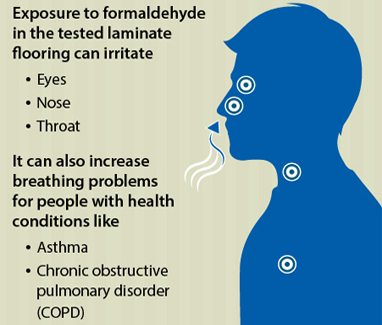
Is Formaldehyde in Futon Frames Dangerous?
Formaldehyde is a strong-smelling, flammable, colorless chemical that is used in building materials used for many household products and can be found in high quantities within the home. Adhesive resin used to manufacture composite wood contains formaldehyde. These materials include; pressed-wood products, such as particleboard, plywood, and fiberboard. Formaldehyde can also be found in glues and adhesives, permanent-press fabrics, paper product coatings, and some insulation materials. Other uses of formaldehyde include as an industrial fungicide, germicide, and disinfectant. Most living organisms produce formaldehyde as a normal byproduct of their metabolic processes. Sources of formaldehyde in the home are furniture, cabinets, many building materials, paper goods, upholstery fabrics and even cosmetics.

It is found in It is the adhesive resin that holds composite woods (such as particleboard, plywood and medium-density fiberboard) together and has a similar function in other products. It is one of the large family of chemical compounds called volatile organic compounds or “VOCs,” meaning that the compound off-gases, or vaporizes, at normal room temperatures. Some other sources of Formaldehyde include: Paints, adhesives, varnishes and floor finishes, wallpaper, cardboard and paper products,Vehicle exhaust from attached garages, Smoke from fireplaces and wood-burning stoves, Tobacco smoke, nail polish, and some hair care products.
Formaldehyde is an important precursor to many other materials and chemical compounds. In 1996, the installed capacity for the production of formaldehyde was estimated to be 8.7 million tons per year.
Commercial solutions of formaldehyde in water, commonly called formol or formalin, were formerly used as disinfectants and for preservation of biological specimens. It is also used for the embalming of human remains.
Formaldehyde has long been associated with irritations of the nasal canal, watery eyes, and burning sensations in the eyes, nose, and throat. Symptoms of exposure to formaldehyde can be difficult to identify because they are similar to cold and flu symptoms, as well as sensitivity to other environmental irritants. In some cases exposure may cause nausea, coughing, chest tightness, wheezing, skin rashes, and allergic reactions. Research has shown a correlation between formaldehyde exposure and the increase in rates of cancer.
In view of its widespread use, toxicity and volatility, exposure to formaldehyde is a significant consideration for human health. In 2011, the US National Toxicology Program described formaldehyde as "known to be a human carcinogen".
For more information of formaldehyde: http://www2.epa.gov/formaldehyde
Everything You Need To Know About Futons

 What Houseplants Are Best For Cleaning The Air?
What Houseplants Are Best For Cleaning The Air? What To Consider When Buying A Futon?
What To Consider When Buying A Futon? Why Buy A Futon?
Why Buy A Futon? What Wood Is Best For Beds?
What Wood Is Best For Beds? What Are Futon Frame Styles?
What Are Futon Frame Styles? What's The Most Comfortable Futon Mattress?
What's The Most Comfortable Futon Mattress? What Are The Sizes Of Futons?
What Are The Sizes Of Futons? How To Care And Maintain Your Futon?
How To Care And Maintain Your Futon? What Furniture Is Best For My Health?
What Furniture Is Best For My Health? What Causes Poor Indoor Air Quality?
What Causes Poor Indoor Air Quality? Do Mattresses Contain Volatile Organic Compounds (VOCs)?
Do Mattresses Contain Volatile Organic Compounds (VOCs)? Sleep VOC Free
Sleep VOC Free What Is Off Gassing?
What Is Off Gassing?





